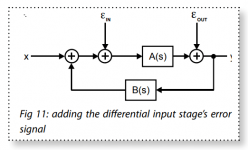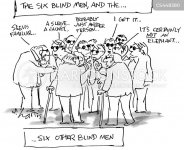A 20kHz sine wave is 50 usec per cycle.
5 us of delay is 5/50 of 360 degrees of one 20kHz cycle; that is 36 degrees.
That means the delayed negative feedback signal is 36 degrees delayed versus the input signal.
Take a 1 volt peak sine wave (2V peak to peak).
The difference between 0 volts at 0 degrees, and the volts at 36 degrees is 0.588 volts.
Suppose the amplifier sine wave curve is distorted when the input is 0.588 volts, what is the corrective negative feedback signal then?
If the input stage signal is at 0.588 volts, then the 5 us delayed output signal is only 0 volts. 0 volts does not seem like a correction signal for the distorted 0.588 volt signal at the input stage.
Distortion of 0.588 volt signal - 0 volt corrective signal = 0.588 volt distorted, and uncorrected signal distortion.
You may think this is only a special case, because I picked 0 degrees, 0 Volts.
Take a compressed signal at 90 degrees (should be 1 volt peak); but the output is lagging by 36 degrees (90 - 36 = 54 degrees).
the 54 degree delayed signal at the output is 0.809 volts. If the distorted signal at 90 degrees is 0.99 volts instead of 1.00 volts (1% distortion), then how good is the correction signal from the delayed feedback that is at 0.809 volts? A properly correcting negative feed back signal would just be 0.01 volts, to add 0.01 volt to the distorted 0.99 volt, so the corrected output would correctly be 1.00 volt.
Delay of the corrective negative feedback signal, not a good thing.
You might want to use some lead compensation to make up for the 5 us delay of the signal path through the amplifier.
Just my opinions
5 us of delay is 5/50 of 360 degrees of one 20kHz cycle; that is 36 degrees.
That means the delayed negative feedback signal is 36 degrees delayed versus the input signal.
Take a 1 volt peak sine wave (2V peak to peak).
The difference between 0 volts at 0 degrees, and the volts at 36 degrees is 0.588 volts.
Suppose the amplifier sine wave curve is distorted when the input is 0.588 volts, what is the corrective negative feedback signal then?
If the input stage signal is at 0.588 volts, then the 5 us delayed output signal is only 0 volts. 0 volts does not seem like a correction signal for the distorted 0.588 volt signal at the input stage.
Distortion of 0.588 volt signal - 0 volt corrective signal = 0.588 volt distorted, and uncorrected signal distortion.
You may think this is only a special case, because I picked 0 degrees, 0 Volts.
Take a compressed signal at 90 degrees (should be 1 volt peak); but the output is lagging by 36 degrees (90 - 36 = 54 degrees).
the 54 degree delayed signal at the output is 0.809 volts. If the distorted signal at 90 degrees is 0.99 volts instead of 1.00 volts (1% distortion), then how good is the correction signal from the delayed feedback that is at 0.809 volts? A properly correcting negative feed back signal would just be 0.01 volts, to add 0.01 volt to the distorted 0.99 volt, so the corrected output would correctly be 1.00 volt.
Delay of the corrective negative feedback signal, not a good thing.
You might want to use some lead compensation to make up for the 5 us delay of the signal path through the amplifier.
Just my opinions
Last edited:
What do you mean by "is distorted when the input is x volts"? That sounds like you are thinking about distortion that looks like some narrow pulse around vin = x V. Smooth distortion just changes the whole sine wave into a somewhat different form.
Or why feedback gets less effective at higher frequencies where the loop gain goes down.
Square waves contain a whole slew or frequencies, so your measurements also cover a whole slew of frequencies.
I'm not sure whether you can usefully draw conclusions about how feedback works or works not in such a situation.
The final arbiter of course is that it is demonstrated to work in a specific situation with a specific frequency; by sweeping the frequencies being measured you get a nice view of what's going on internally. With square waves, the view is pretty muddled.
Jan
Square waves contain a whole slew or frequencies, so your measurements also cover a whole slew of frequencies.
I'm not sure whether you can usefully draw conclusions about how feedback works or works not in such a situation.
The final arbiter of course is that it is demonstrated to work in a specific situation with a specific frequency; by sweeping the frequencies being measured you get a nice view of what's going on internally. With square waves, the view is pretty muddled.
Jan
That means the delayed negative feedback signal is 36 degrees delayed versus the input signal.
[]
Delay of the corrective negative feedback signal, not a good thing.
You really should get away from looking at phaseshift as delay. You should know better by now.
If you subtract (in the feedback summer) a input 20kHz sine wave from another fed back 20kHz sine wave that is 10deg phase shifted, you still have a 20kHz sine wave. Because the subtraction is not complete (due to the phase shift), there's a remaining 20kHz sinewave meaning the distortion is not 100% nulled out.
When frequency rises, phase shift rises, subtraction gets less and less complete and distortion gets less and less supressed.
That's exactly what we see; with rising frequencies, distortion reduction falls.
In general, phase shift rises with rising frequency; also the gain falls with rising frequency, which in turn means there's less feedback available with rising frequencies.
The increasing phase shift and decreasing distortion reduction with rising frequency is just another manifestation of decreasing loop gain.
Jan
Ignoring dynamics:
Output = gain( input - output* feedback attenuation). So O=gi-gOf, O(1+gf)=gi, O=gi/(1+gf)
Say you have a gain of 100 and feedback of 10%, then the output is input*100/11 = input* 9.09...
If you had a gain of 100 and 50% feedback, then the output is the input*100/51= input *1.96
If you had a gain of 10 and 50% feedback, then the output is the input*10/6 = input *1.666...
Output = gain( input - output* feedback attenuation). So O=gi-gOf, O(1+gf)=gi, O=gi/(1+gf)
Say you have a gain of 100 and feedback of 10%, then the output is input*100/11 = input* 9.09...
If you had a gain of 100 and 50% feedback, then the output is the input*100/51= input *1.96
If you had a gain of 10 and 50% feedback, then the output is the input*10/6 = input *1.666...
That's the classical feedback gain equation G(cl) = G(ol)/(1+Fb* G(ol)) .
The reasoning being, that when G(ol) is very large, Fb*G(ol) is very large, and the '1' can be ignored.
The equation then becomes G(cl) = 1/Fb . Harold Black, 1934.
If the G(ol) is not very large with respect to the '1' then Steveu's equation above gives a more precise answer.
Note also that when you include 'dynamics' the pictures gets more involved; without it, it is only valid at DC.
Jan
The reasoning being, that when G(ol) is very large, Fb*G(ol) is very large, and the '1' can be ignored.
The equation then becomes G(cl) = 1/Fb . Harold Black, 1934.
If the G(ol) is not very large with respect to the '1' then Steveu's equation above gives a more precise answer.
Note also that when you include 'dynamics' the pictures gets more involved; without it, it is only valid at DC.
Jan
Perfectly valid for AC if G(ol) and Fb are proper functions of omega. Then you can even determine if it will be stable.
The trick is determining those functions exactly. Especially for the transformer. Not exactly paper math I’m looking forward to. In my own “fuzzy math” I tend to make a few approximations that work most of the time. But sometimes I get burned by it…..
The trick is determining those functions exactly. Especially for the transformer. Not exactly paper math I’m looking forward to. In my own “fuzzy math” I tend to make a few approximations that work most of the time. But sometimes I get burned by it…..
If the distorted signal at 90 degrees is 0.99 volts instead of 1.00 volts (1% distortion), then how good is the correction signal from the delayed feedback that is at 0.809 volts? A properly correcting negative feed back signal would just be 0.01 volts, to add 0.01 volt to the distorted 0.99 volt, so the corrected output would correctly be 1.00 volt.
This is not an example of distortion. It is an example of roll-off in frequency response. NFB does not add to any signal to make it higher, it only lowers the gain of the higher levels, in proportion, so that lower levels get less attenuation and thus better represent the amplitudes of the original signal in their proportion of the music. So if signals aren't there to start with, but appear at the OP,T then those unwanted frequencies are lowered by any FB that matches their frequency, albeit not 100% perfectly as the frequencies get higher unless some phase correction is applied. Which is why phase correction is applied... sometimes.
So if a fundamental 7.5kHz signal has a 5% HD (15kHz @ 5% of the dB level of the fundamental), and that 5% is reduced by 80%, what do you think you are going to hear of it?
Ten years ago these were less than $100, now they are $300 and probably don't work.
Global N Fdbk should be transitioned to local N Fdbk at the HF end, so the tube distortion is fixed throughout the audio band.
OT distortion is a low frequency thing. Air gapping makes for high magnetizing current.
Last edited:
The detail is still not so clear for me. Consider two different two-stage amplifiers. The apparent worst case scenario in terms of distortion contribution to the output is when open loop the first and second stages both contribute additive and equally to total distortion output. I.e. the first gain stage's 2nd harmonic amplified by the output stage gain matches the output stage's 2nd harmonic level. If correct that means the two stage circuit output has 6 dB more absolute THD level than the output stage alone. Compare that to an amplifier with a perfectly linear first stage but an output stage with 6 dB more 2nd harmonic THD than the first example. The general output THD level for both examples should be roughly equivalent since the first amplifier's 2nd harmonic distortion of its first stage's 2nd harmonic distortion should be too low significantly contribute.In very general terms, the distortion is reduced by the feedback factor.
Now close both loops with equal amounts of feedback. The imperfect feedback error correction of the first amplifier intuitively results in (potentially significant, depending on stage linearity) differences in THD spectra than the second amp with error-less feedback degeneration. The closest discussion I found so far is in the F-Word paper around the attached block diagram but it didn't really dive into the detail of harmonic spectra. I'm also uncomfortable with what seems to be simplifying circuit error to a linear constant scalar but that might be my own lack of understanding.
Where it relates to tube design is understanding the best places to apply feedback. The next project on the bench is a push pull based on Rowe OPTs with 70 volt secondaries suitable for output cathode feedback. When optimizing for THD spectrum (as opposed to just ultimate level) should they be ignored in favour of a very high gain pentode first gain/FB stage with 'ok-ish' thd? Use the 70 volts taps with lower gain first stage optimized for minimum distortion? Mix them with output/phase splitter degeneration? Etc..
Attachments
I have found out that with CFB for each decibel of cathode feedback I get about 2 decibels of reduction in overall THD. With most pentodes 10-15% CFB gives triode-like specs with the efficiency of the pentodes. The additional voltage drive is not too bad and significantly less than DHT's that give similar output power. Last amp I have played with is EL34 PP with 430V plate voltage and 400V g2 (simply regulated with Zener diodes) and 45-50 mA anode current for each tube, 10% CFB. About 150V grid-to-grid required for 60W output power. The gain is reduced by 7 dB but distortion is 13 dB less (just under 1% instead of 4%). Distortion of the driver stage has to be low (quite less than 1% in my case).Where it relates to tube design is understanding the best places to apply feedback. The next project on the bench is a push pull based on Rowe OPTs with 70 volt secondaries suitable for output cathode feedback.
Last edited:
It is phase shift, not time shift. Negative feedback is 180 degrees phase shift at all frequencies, fed back to the input. If it were delay, the phase difference would be frequency dependent: virtually zero at low frequency, going through 180 degrees somewhere, and 360 degrees (in phase) again at a certain frequency. This is true for sine wave. For real audio signal we simply invert the signal and call it 180 degrees phase shift. A reactive circuit element (an inductor or a capacitor) will increase or decrease this phase shift - again frequency dependent.Delay of the corrective negative feedback signal, not a good thing.
Subsequent distortion of the N Fdbk signal itself going thru the amplifier just looks like a small additional error component (for the next moment) that will get (mostly) fixed by a second loop thru the Fdbk loop. As long as the amplifier has plenty of excess bandwidth and correct phase compensation, the results will quickly converge to what the feedback equation predicted. Higher frequency input signals and higher harmonic distortions will deplete the excess amplifier bandwidth available for multi-looping. So good practice removing the OT from the loop at higher frequencies by HF transition to a local loop. Important OT distortions occur at low frequency anyway.
Last edited:
Why does all this folklore refuse to die?
The feedback doesn't go around and around. There is no going around. It's a continuous process, purely analog.
I give up.
Jan
The feedback doesn't go around and around. There is no going around. It's a continuous process, purely analog.
I give up.
Jan
The result looks like a continuous process. On the time scale of the amplifier HF limit there is some small amount of circulating re-correction to the initial distortion correction. This makes the output converge quickly to what the feedback factor predicts, not worse distortions as usually assumed.
The well known article showing increasing higher harmonics to a second harmonic distortion. at low N Fdbk. is just demonstrating how discrete integer FFT mathematical modeling displays something a little lower than a second harmonic. A second harmonic gives a single line discrete integer spectrum. and say a 1.99 harmonic. has a long tailing off series of higher harmonics. It doesn't sound any worse. Discrete FFTs can be quite misleading.
This Fdbk looping is similar to the brief time scale of connecting a resistor across a twisted wire pair from a power supply. Initially current flows from the power supply according to the twisted pair line impedance. But a reflected voltage correction occurs when that reaches the resistor, if that does not match the line impedance. This step wise series of corrections bounces back and forth between power supply and load until the line current quickly converges to the expected resistor draw, and continuously from then on. You would need a real fast O'scope to see this. (like a TDR) Changing the resistor value would cause a continuous series of current reflections to adjust the current to match. Great example for those claiming no Fdbk occurs in Nature. On the contrary. N Fdbk is absolutely everywhere, even in the Quantum world with virtual particles.
The well known article showing increasing higher harmonics to a second harmonic distortion. at low N Fdbk. is just demonstrating how discrete integer FFT mathematical modeling displays something a little lower than a second harmonic. A second harmonic gives a single line discrete integer spectrum. and say a 1.99 harmonic. has a long tailing off series of higher harmonics. It doesn't sound any worse. Discrete FFTs can be quite misleading.
This Fdbk looping is similar to the brief time scale of connecting a resistor across a twisted wire pair from a power supply. Initially current flows from the power supply according to the twisted pair line impedance. But a reflected voltage correction occurs when that reaches the resistor, if that does not match the line impedance. This step wise series of corrections bounces back and forth between power supply and load until the line current quickly converges to the expected resistor draw, and continuously from then on. You would need a real fast O'scope to see this. (like a TDR) Changing the resistor value would cause a continuous series of current reflections to adjust the current to match. Great example for those claiming no Fdbk occurs in Nature. On the contrary. N Fdbk is absolutely everywhere, even in the Quantum world with virtual particles.
Last edited:
I think it's safe to say that feedback is causally recursive. Without it, Black's equation would be exact, rather than an approximation.
All good fortune,
Chris
All good fortune,
Chris
Is this referring to the Putzeys "F-word" article? I'm not following along at all here.The well known article showing increasing higher harmonics to a second harmonic distortion. at low N Fdbk. is just demonstrating how FFT mathematical modeling displays something lower than a second harmonic. A second harmonic gives a single line spectrum and say a 1.99 harmonic has a long tailing off series of higher harmonics. It doesn't sound any worse. FFTs can be quite misleading.
All good fortune,
Chris
- Home
- Amplifiers
- Tubes / Valves
- Negative Feedback




